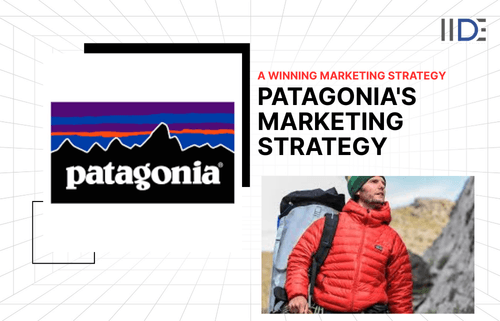
Updated on Dec 11, 2025
Share on:
Patagonia’s marketing strategy heavily relies on storytelling, sustainability-driven campaigns, and community engagement rather than traditional advertising. Patagonia spends less than 1% of revenue on paid media and instead invests in content, activism, and word-of-mouth marketing, proving that authenticity sells.
Before diving into the article, I’d like to share that the research and initial analysis for this piece were conducted by Drashti Mistry, a current student in IIDE’s Post Graduation in Digital Marketing & Strategy Course (March 2025 Batch).
If you find this case study on Patagonia’s marketing strategy insightful, feel free to connect with Drashti Mistry and send her a note of appreciation for her fantastic research - she’ll truly value the encouragement!
About Patagonia
Patagonia is not just an American outdoor apparel brand - it’s a movement for sustainability and conscious consumerism founded in 1973 by Yvon Chouinard. Unlike many fashion brands, Patagonia is known for its bold stance on environmental activism and ethical production, building a cult-like following across the globe.

With the mission statement, “We’re in business to save our home planet,” Patagonia sets itself apart from traditional fashion and sportswear brands. Operating in 10+ countries with annual revenue surpassing $1.5 billion (2023), Patagonia has created a strong global presence while staying true to its eco-conscious roots.


Learn Digital Marketing for FREE


Marketing Objective or Business Challenge
Despite offering high-quality, purpose-driven products, Patagonia faced notable challenges in the market. The brand operated in a competitive landscape where fast-fashion and conventional outdoor brands dominated consumer attention and spending.
Key challenges included balancing growth with its environmental mission, encouraging mindful consumption in a market built on frequent purchases, and overcoming scepticism around “greenwashing.” Educating customers about sustainable practices and the long-term value of products was essential.
Patagonia’s goals were clear: to build trust and loyalty while staying true to its mission. The brand leveraged initiatives such as Worn Wear, activism-driven campaigns, and earned media to enhance visibility, strengthen credibility, and drive community engagement, expanding globally without compromising its core values.
Buyers Persona:

Emily Johnson
Seattle
Occupation: Marketing Manager
Age: 29 years
Motivation
- Sustainability
- Comparing brands
Interest & Hobbies
- Hiking
- Photography
Pain Points
- Accessibility
- Budget
Social Media Presence
- YouTube
Marketing Channels Used by Patagonia
Patagonia utilised a multi-channel mix of digital, social, and offline platforms to execute its campaigns. Instead of relying on traditional advertising, the brand focused on:
- Print Media & Press to grab global attention instantly.
- Use of Social Media Platforms (Instagram, YouTube, Twitter/X) for the campaign’s better reach by doing storytelling posts, videos, and real customer testimonials.
- Owned Media (Website & Blog), carrying campaign messaging, repair guides and resale options.
- Paid Ads through Google and remarketing them
- Writing a Blog and giving the campaign’s message through their official website.
- In-Store Activations, where customers could bring old gear to repair instead of replacing it.
- Events & Pop-Ups: Setting up repair vans and building grassroots-level engagement.
- Partnering with activists, explorers and environmentalists.
When it comes to sales, Patagonia prioritises direct-to-consumer (D2C) sales through its website and stores, creating a circular business model.
Patagonia’s Marketing Strategy Breakdown
1. Print Media & Press
Patagonia kicked off its iconic Don’t Buy This Jacket campaign through a full-page ad in The New York Times on Black Friday. This bold move stood out in a season dominated by aggressive sales promotions. Instead of pushing for purchases, Patagonia encouraged people to rethink consumption and consider the environmental cost of buying new products.
- Used shock-value messaging to spark conversations.
- Gained massive earned media coverage globally without heavy ad spend.
2. Social Media Platforms (Instagram, YouTube, Twitter/X)
To scale its campaigns, Patagonia turned to social media storytelling. Platforms like Instagram and YouTube were used to highlight not just products, but the values and activism behind the brand.
- Shared short films, storytelling posts, and repair tutorials to connect with audiences.
- Featured real customer testimonials to showcase trust and authenticity.
- Encouraged hashtags like #WornWear, building a community around conscious consumption.
3. Owned Media (Website & Blog)
Patagonia leveraged its website and official blog, The Cleanest Line, to educate and inform. Instead of sales-driven content, these platforms focused on sustainability.
- Published repair guides, environmental blogs, and campaign updates.
- Offered resale and repair options through Worn Wear, reinforcing its “reduce and reuse” message.
- Used the blog to humanise the brand by sharing customer and activist stories.
4. Paid Ads and Remarketing
In June 2020, Patagonia stopped all paid advertising on Facebook and Instagram to protest the spread of hate speech and misinformation about climate change and democracy on those platforms. They still invest in digital advertising on other platforms, using strategies like Google Ads for targeted keyword promotion and remarketing campaigns to re-engage customers.
- Patagonia runs Google Ads targeting specific keywords related to sustainable outdoor products.
- Remarketing campaigns are used to re-engage users who have previously visited the website but haven’t completed a purchase, enticing them to return with personalised offers.
5. In-Store Activations
The Worn Wear program wasn’t limited to online channels—it extended to physical stores. Customers were invited to bring in old Patagonia gear to repair instead of replacing it, turning shopping spaces into community hubs.
- Hosted free repair workshops on zippers, buttons, and tears.
- Reinforced Patagonia’s commitment to long product life cycles.
- Created loyalty and trust by helping customers extend the use of their purchases.
6. Events & Pop-Ups
Patagonia made sustainability experiential by taking its message on the road. The Worn Wear Tour featured mobile repair vans that travelled across cities, universities, and events.
- Offered free on-the-spot gear repairs for customers and non-customers alike.
- Built grassroots engagement by directly interacting with local communities.
- Turned environmental activism into a shared lifestyle experience.
Results & Impact
The ~1% revenue from resale may look small. Still, it's a meaningful start: it shows Patagonia’s resale business is no longer marginal - it is being scaled and integrated into the core business.
“Record year” status for Worn Wear & ReCrafted suggests rising demand for sustainable, pre-owned, and upcycled products. Patagonia is benefiting from increasing consumer preferences for circular fashion.
The 120,000+ used items in circulation demonstrate actual impact in terms of product reuse—it’s not just rhetoric. It helps counter greenwashing concerns with real numbers.
Younger customer adoption is critical for Patagonia’s long-term brand health; bringing in younger consumers through resale & conscious practices helps build future loyalty.
Large online GMV in the hundreds of millions indicates that Patagonia’s core business remains strong, giving it leeway to experiment with resale/repair without jeopardising its financial health.
What Worked & Why
Authenticity: Patagonia’s “Don’t Buy This Jacket” campaign worked because it was real, not a gimmick.
Activism as a Differentiator: While competitors chase trends, Patagonia champions causes, creating emotional resonance.
Community Building: Programs like Worn Wear transformed customers into a movement.
What Didn’t Work & Why
Limited Accessibility: Products remain premium-priced, restricting reach.
Scaling Challenges: Expanding globally without compromising sustainability is tough.
Niche Appeal: While adored by eco-conscious consumers, Patagonia doesn’t aggressively capture the mass market.
Explore how Puma's 2025 marketing strategy integrates innovation, collaboration, and digital platforms to enhance its global brand presence in this comprehensive case study.
IIDE Student Recommendations: Key Areas for Brand Improvement
Leverage User-Generated Proof
One of the most effective ways to counter greenwashing scepticism is by letting customers become the storytellers.
Instead of relying solely on brand-driven content, Patagonia can amplify the authentic voices of its community.
- Before-and-After Stories: Customers who repair their Patagonia jackets, backpacks, or gear can share transformation photos showing the product’s extended life. This provides tangible evidence that repair initiatives, such as Worn Wear, are effective in practice.
- Upcycling Hacks: Encouraging users to post creative ways of repurposing old gear - like turning a torn jacket into a tote bag - demonstrates Patagonia’s commitment to circular fashion.
- Longevity Testimonials: Highlighting customers who have used the same Patagonia product for 10+ years reinforces durability and sustainability claims.
By promoting these stories under dedicated hashtags (e.g., #MyWornWear, #PatagoniaProof) and featuring them across Patagonia’s social media and website, the brand can build a library of real-life case studies created by its own customers.
This type of user-generated proof is more powerful than traditional ads because it’s rooted in authentic experiences, making Patagonia’s activism credible and relatable.
Want to Know Why 2,50,000+ Students Trust Us?
Dive into the numbers that make us the #1 choice for career success

MBA - Level
Best For
Fresh Graduates
Mode of Learning
On Campus (Mumbai & Delhi)
Starts from
Jan 5, 2026
Duration
11 Months
Live & Online
Best For
Working Professionals
Mode of Learning
Online
Starts from
Dec 19, 2025
Duration
4-6 Months

Online
Best For
AI Enthusiasts
Mode of Learning
Online
Duration
5 Months

Offline
Best For
12th Passouts
Mode of Learning
On Campus (Mumbai)
Duration
3 Years
Recent Post
You May Also Like
Aditya Shastri leads the Business Development segment at IIDE and is a seasoned Content Marketing expert. With over a decade of experience, Aditya has trained more than 20,000 students and professionals in digital marketing, collaborating with prestigious institutions and corporations such as Jet Airways, Godrej Professionals, Pfizer, Mahindra Group, Publicis Worldwide, and many others. His ability to simplify complex marketing concepts, combined with his engaging teaching style, has earned him widespread admiration from students and professionals alike.
Aditya has spearheaded IIDE’s B2B growth, forging partnerships with over 40 higher education institutions across India to upskill students in digital marketing and business skills. As a visiting faculty member at top institutions like IIT Bhilai, Mithibai College, Amity University, and SRCC, he continues to influence the next generation of marketers.
Apart from his marketing expertise, Aditya is also a spiritual speaker, often traveling internationally to share insights on spirituality. His unique blend of digital marketing proficiency and spiritual wisdom makes him a highly respected figure in both fields.